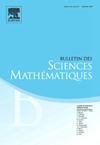广义分数(加权)Morrey空间积上的双线性广义核奇异积分算子及其对易子
IF 0.9
3区 数学
Q2 MATHEMATICS, APPLIED
Guanghui Lu, Miaomiao Wang, Shuangping Tao, Ronghui Liu
{"title":"广义分数(加权)Morrey空间积上的双线性广义核奇异积分算子及其对易子","authors":"Guanghui Lu, Miaomiao Wang, Shuangping Tao, Ronghui Liu","doi":"10.1016/j.bulsci.2024.103544","DOIUrl":null,"url":null,"abstract":"<div><div>The purpose of this article is to establish the boundedness of a bilinear singular integral operator <span><math><mover><mrow><mi>T</mi></mrow><mrow><mo>˜</mo></mrow></mover></math></span> with generalized kernels and its commutator <span><math><msub><mrow><mover><mrow><mi>T</mi></mrow><mrow><mo>˜</mo></mrow></mover></mrow><mrow><msub><mrow><mi>b</mi></mrow><mrow><mn>1</mn></mrow></msub><mo>,</mo><msub><mrow><mi>b</mi></mrow><mrow><mn>2</mn></mrow></msub></mrow></msub></math></span> formed by <span><math><msub><mrow><mi>b</mi></mrow><mrow><mn>1</mn></mrow></msub><mo>,</mo><msub><mrow><mi>b</mi></mrow><mrow><mn>2</mn></mrow></msub><mo>∈</mo><mrow><mi>BMO</mi></mrow><mo>(</mo><msup><mrow><mi>R</mi></mrow><mrow><mi>n</mi></mrow></msup><mo>)</mo></math></span> and the <span><math><mover><mrow><mi>T</mi></mrow><mrow><mo>˜</mo></mrow></mover></math></span> on product of generalized fractional Morrey spaces <span><math><msup><mrow><mi>L</mi></mrow><mrow><msub><mrow><mi>p</mi></mrow><mrow><mn>1</mn></mrow></msub><mo>,</mo><msub><mrow><mi>η</mi></mrow><mrow><mn>1</mn></mrow></msub><mo>,</mo><mi>φ</mi></mrow></msup><mo>(</mo><msup><mrow><mi>R</mi></mrow><mrow><mi>n</mi></mrow></msup><mo>)</mo><mo>×</mo><msup><mrow><mi>L</mi></mrow><mrow><msub><mrow><mi>p</mi></mrow><mrow><mn>2</mn></mrow></msub><mo>,</mo><msub><mrow><mi>η</mi></mrow><mrow><mn>2</mn></mrow></msub><mo>,</mo><mi>φ</mi></mrow></msup><mo>(</mo><msup><mrow><mi>R</mi></mrow><mrow><mi>n</mi></mrow></msup><mo>)</mo></math></span>, product of generalized fractional weighted Morrey spaces <span><math><msubsup><mrow><mi>L</mi></mrow><mrow><msub><mrow><mi>ω</mi></mrow><mrow><mn>1</mn></mrow></msub></mrow><mrow><msub><mrow><mi>p</mi></mrow><mrow><mn>1</mn></mrow></msub><mo>,</mo><msub><mrow><mi>η</mi></mrow><mrow><mn>1</mn></mrow></msub><mo>,</mo><mi>φ</mi></mrow></msubsup><mo>(</mo><msup><mrow><mi>R</mi></mrow><mrow><mi>n</mi></mrow></msup><mo>)</mo><mo>×</mo><msubsup><mrow><mi>L</mi></mrow><mrow><msub><mrow><mi>ω</mi></mrow><mrow><mn>2</mn></mrow></msub></mrow><mrow><msub><mrow><mi>p</mi></mrow><mrow><mn>2</mn></mrow></msub><mo>,</mo><msub><mrow><mi>η</mi></mrow><mrow><mn>2</mn></mrow></msub><mo>,</mo><mi>φ</mi></mrow></msubsup><mo>(</mo><msup><mrow><mi>R</mi></mrow><mrow><mi>n</mi></mrow></msup><mo>)</mo></math></span> and product of grand generalized fractional weighted Morrey spaces <span><math><msubsup><mrow><mi>L</mi></mrow><mrow><msub><mrow><mi>ω</mi></mrow><mrow><mn>1</mn></mrow></msub></mrow><mrow><msub><mrow><mi>p</mi></mrow><mrow><mn>1</mn></mrow></msub><mo>)</mo><mo>,</mo><msub><mrow><mi>η</mi></mrow><mrow><mn>1</mn></mrow></msub><mo>,</mo><mi>φ</mi><mo>,</mo><mi>θ</mi><mo>,</mo><mi>σ</mi></mrow></msubsup><mo>(</mo><msup><mrow><mi>R</mi></mrow><mrow><mi>n</mi></mrow></msup><mo>)</mo><mo>×</mo><msubsup><mrow><mi>L</mi></mrow><mrow><msub><mrow><mi>ω</mi></mrow><mrow><mn>2</mn></mrow></msub></mrow><mrow><msub><mrow><mi>p</mi></mrow><mrow><mn>2</mn></mrow></msub><mo>)</mo><mo>,</mo><msub><mrow><mi>η</mi></mrow><mrow><mn>2</mn></mrow></msub><mo>,</mo><mi>φ</mi><mo>,</mo><mi>θ</mi><mo>,</mo><mi>σ</mi></mrow></msubsup><mo>(</mo><msup><mrow><mi>R</mi></mrow><mrow><mi>n</mi></mrow></msup><mo>)</mo></math></span>, where <span><math><mi>φ</mi><mo>(</mo><mo>⋅</mo><mo>)</mo></math></span> is a positive, increasing function defined on <span><math><mo>[</mo><mn>0</mn><mo>,</mo><mo>∞</mo><mo>)</mo></math></span> and satisfies doubling conditions, <em>ω</em> is an <span><math><msub><mrow><mi>A</mi></mrow><mrow><mi>p</mi></mrow></msub><mo>(</mo><msup><mrow><mi>R</mi></mrow><mrow><mi>n</mi></mrow></msup><mo>)</mo></math></span> weight, <span><math><mi>θ</mi><mo>></mo><mn>0</mn></math></span>, <span><math><mi>σ</mi><mo><</mo><mi>p</mi><mo>−</mo><mn>1</mn></math></span> and <span><math><mi>p</mi><mo>∈</mo><mo>(</mo><mn>1</mn><mo>,</mo><mfrac><mrow><mi>n</mi></mrow><mrow><mi>η</mi></mrow></mfrac><mo>)</mo></math></span> with <span><math><mi>η</mi><mo>∈</mo><mo>(</mo><mn>0</mn><mo>,</mo><mi>n</mi><mo>)</mo></math></span>. Via some known results, the authors show that the <span><math><mover><mrow><mi>T</mi></mrow><mrow><mo>˜</mo></mrow></mover></math></span> and <span><math><msub><mrow><mover><mrow><mi>T</mi></mrow><mrow><mo>˜</mo></mrow></mover></mrow><mrow><msub><mrow><mi>b</mi></mrow><mrow><mn>1</mn></mrow></msub><mo>,</mo><msub><mrow><mi>b</mi></mrow><mrow><mn>2</mn></mrow></msub></mrow></msub></math></span> associated with BMO functions are bounded from product of spaces <span><math><msup><mrow><mi>L</mi></mrow><mrow><msub><mrow><mi>p</mi></mrow><mrow><mn>1</mn></mrow></msub><mo>,</mo><msub><mrow><mi>η</mi></mrow><mrow><mn>1</mn></mrow></msub><mo>,</mo><mi>φ</mi></mrow></msup><mo>(</mo><msup><mrow><mi>R</mi></mrow><mrow><mi>n</mi></mrow></msup><mo>)</mo><mo>×</mo><msup><mrow><mi>L</mi></mrow><mrow><msub><mrow><mi>p</mi></mrow><mrow><mn>2</mn></mrow></msub><mo>,</mo><msub><mrow><mi>η</mi></mrow><mrow><mn>2</mn></mrow></msub><mo>,</mo><mi>φ</mi></mrow></msup><mo>(</mo><msup><mrow><mi>R</mi></mrow><mrow><mi>n</mi></mrow></msup><mo>)</mo></math></span> into spaces <span><math><msup><mrow><mi>L</mi></mrow><mrow><mi>p</mi><mo>,</mo><mi>η</mi><mo>,</mo><mi>φ</mi></mrow></msup><mo>(</mo><msup><mrow><mi>R</mi></mrow><mrow><mi>n</mi></mrow></msup><mo>)</mo></math></span>, and they are also bounded from product of spaces <span><math><msup><mrow><mi>L</mi></mrow><mrow><msub><mrow><mi>p</mi></mrow><mrow><mn>1</mn></mrow></msub><mo>,</mo><msub><mrow><mi>η</mi></mrow><mrow><mn>1</mn></mrow></msub><mo>,</mo><mi>φ</mi></mrow></msup><mo>(</mo><msup><mrow><mi>R</mi></mrow><mrow><mi>n</mi></mrow></msup><mo>)</mo><mo>×</mo><msup><mrow><mi>L</mi></mrow><mrow><msub><mrow><mi>p</mi></mrow><mrow><mn>2</mn></mrow></msub><mo>,</mo><msub><mrow><mi>η</mi></mrow><mrow><mn>2</mn></mrow></msub><mo>,</mo><mi>φ</mi></mrow></msup><mo>(</mo><msup><mrow><mi>R</mi></mrow><mrow><mi>n</mi></mrow></msup><mo>)</mo></math></span> into generalized fractional weak Morrey spaces <span><math><mi>W</mi><msup><mrow><mi>L</mi></mrow><mrow><mi>p</mi><mo>,</mo><mi>η</mi><mo>,</mo><mi>φ</mi></mrow></msup><mo>(</mo><msup><mrow><mi>R</mi></mrow><mrow><mi>n</mi></mrow></msup><mo>)</mo></math></span>, where <span><math><mi>η</mi><mo>=</mo><msub><mrow><mi>η</mi></mrow><mrow><mn>1</mn></mrow></msub><mo>+</mo><msub><mrow><mi>η</mi></mrow><mrow><mn>2</mn></mrow></msub></math></span> and <span><math><mfrac><mrow><mn>1</mn></mrow><mrow><mi>p</mi></mrow></mfrac><mo>=</mo><mfrac><mrow><mn>1</mn></mrow><mrow><msub><mrow><mi>p</mi></mrow><mrow><mn>1</mn></mrow></msub></mrow></mfrac><mo>+</mo><mfrac><mrow><mn>1</mn></mrow><mrow><msub><mrow><mi>p</mi></mrow><mrow><mn>2</mn></mrow></msub></mrow></mfrac></math></span> for <span><math><msub><mrow><mi>p</mi></mrow><mrow><mi>i</mi></mrow></msub><mo>∈</mo><mo>(</mo><mn>1</mn><mo>,</mo><mfrac><mrow><mi>n</mi></mrow><mrow><msub><mrow><mi>η</mi></mrow><mrow><mi>i</mi></mrow></msub></mrow></mfrac><mo>)</mo><mo>(</mo><mi>i</mi><mo>=</mo><mn>1</mn><mo>,</mo><mn>2</mn><mo>)</mo></math></span>. Furthermore, the boundedness of the <span><math><mover><mrow><mi>T</mi></mrow><mrow><mo>˜</mo></mrow></mover></math></span> and <span><math><msub><mrow><mover><mrow><mi>T</mi></mrow><mrow><mo>˜</mo></mrow></mover></mrow><mrow><msub><mrow><mi>b</mi></mrow><mrow><mn>1</mn></mrow></msub><mo>,</mo><msub><mrow><mi>b</mi></mrow><mrow><mn>2</mn></mrow></msub></mrow></msub></math></span> on product of spaces <span><math><msubsup><mrow><mi>L</mi></mrow><mrow><msub><mrow><mi>ω</mi></mrow><mrow><mn>1</mn></mrow></msub></mrow><mrow><msub><mrow><mi>p</mi></mrow><mrow><mn>1</mn></mrow></msub><mo>,</mo><msub><mrow><mi>η</mi></mrow><mrow><mn>1</mn></mrow></msub><mo>,</mo><mi>φ</mi></mrow></msubsup><mo>(</mo><msup><mrow><mi>R</mi></mrow><mrow><mi>n</mi></mrow></msup><mo>)</mo><mo>×</mo><msubsup><mrow><mi>L</mi></mrow><mrow><msub><mrow><mi>ω</mi></mrow><mrow><mn>2</mn></mrow></msub></mrow><mrow><msub><mrow><mi>p</mi></mrow><mrow><mn>2</mn></mrow></msub><mo>,</mo><msub><mrow><mi>η</mi></mrow><mrow><mn>2</mn></mrow></msub><mo>,</mo><mi>φ</mi></mrow></msubsup><mo>(</mo><msup><mrow><mi>R</mi></mrow><mrow><mi>n</mi></mrow></msup><mo>)</mo></math></span> and product of spaces <span><math><msubsup><mrow><mi>L</mi></mrow><mrow><msub><mrow><mi>ω</mi></mrow><mrow><mn>1</mn></mrow></msub></mrow><mrow><msub><mrow><mi>p</mi></mrow><mrow><mn>1</mn></mrow></msub><mo>)</mo><mo>,</mo><msub><mrow><mi>η</mi></mrow><mrow><mn>1</mn></mrow></msub><mo>,</mo><mi>φ</mi><mo>,</mo><mi>θ</mi><mo>,</mo><mi>σ</mi></mrow></msubsup><mo>(</mo><msup><mrow><mi>R</mi></mrow><mrow><mi>n</mi></mrow></msup><mo>)</mo><mo>×</mo><msubsup><mrow><mi>L</mi></mrow><mrow><msub><mrow><mi>ω</mi></mrow><mrow><mn>2</mn></mrow></msub></mrow><mrow><msub><mrow><mi>p</mi></mrow><mrow><mn>2</mn></mrow></msub><mo>)</mo><mo>,</mo><msub><mrow><mi>η</mi></mrow><mrow><mn>2</mn></mrow></msub><mo>,</mo><mi>φ</mi><mo>,</mo><mi>θ</mi><mo>,</mo><mi>σ</mi></mrow></msubsup><mo>(</mo><msup><mrow><mi>R</mi></mrow><mrow><mi>n</mi></mrow></msup><mo>)</mo></math></span> is obtained, respectively.</div></div>","PeriodicalId":55313,"journal":{"name":"Bulletin des Sciences Mathematiques","volume":"199 ","pages":"Article 103544"},"PeriodicalIF":0.9000,"publicationDate":"2024-11-29","publicationTypes":"Journal Article","fieldsOfStudy":null,"isOpenAccess":false,"openAccessPdf":"","citationCount":"0","resultStr":"{\"title\":\"Bilinear singular integral operators with generalized kernels and their commutators on product of (grand) generalized fractional (weighted) Morrey spaces\",\"authors\":\"Guanghui Lu, Miaomiao Wang, Shuangping Tao, Ronghui Liu\",\"doi\":\"10.1016/j.bulsci.2024.103544\",\"DOIUrl\":null,\"url\":null,\"abstract\":\"<div><div>The purpose of this article is to establish the boundedness of a bilinear singular integral operator <span><math><mover><mrow><mi>T</mi></mrow><mrow><mo>˜</mo></mrow></mover></math></span> with generalized kernels and its commutator <span><math><msub><mrow><mover><mrow><mi>T</mi></mrow><mrow><mo>˜</mo></mrow></mover></mrow><mrow><msub><mrow><mi>b</mi></mrow><mrow><mn>1</mn></mrow></msub><mo>,</mo><msub><mrow><mi>b</mi></mrow><mrow><mn>2</mn></mrow></msub></mrow></msub></math></span> formed by <span><math><msub><mrow><mi>b</mi></mrow><mrow><mn>1</mn></mrow></msub><mo>,</mo><msub><mrow><mi>b</mi></mrow><mrow><mn>2</mn></mrow></msub><mo>∈</mo><mrow><mi>BMO</mi></mrow><mo>(</mo><msup><mrow><mi>R</mi></mrow><mrow><mi>n</mi></mrow></msup><mo>)</mo></math></span> and the <span><math><mover><mrow><mi>T</mi></mrow><mrow><mo>˜</mo></mrow></mover></math></span> on product of generalized fractional Morrey spaces <span><math><msup><mrow><mi>L</mi></mrow><mrow><msub><mrow><mi>p</mi></mrow><mrow><mn>1</mn></mrow></msub><mo>,</mo><msub><mrow><mi>η</mi></mrow><mrow><mn>1</mn></mrow></msub><mo>,</mo><mi>φ</mi></mrow></msup><mo>(</mo><msup><mrow><mi>R</mi></mrow><mrow><mi>n</mi></mrow></msup><mo>)</mo><mo>×</mo><msup><mrow><mi>L</mi></mrow><mrow><msub><mrow><mi>p</mi></mrow><mrow><mn>2</mn></mrow></msub><mo>,</mo><msub><mrow><mi>η</mi></mrow><mrow><mn>2</mn></mrow></msub><mo>,</mo><mi>φ</mi></mrow></msup><mo>(</mo><msup><mrow><mi>R</mi></mrow><mrow><mi>n</mi></mrow></msup><mo>)</mo></math></span>, product of generalized fractional weighted Morrey spaces <span><math><msubsup><mrow><mi>L</mi></mrow><mrow><msub><mrow><mi>ω</mi></mrow><mrow><mn>1</mn></mrow></msub></mrow><mrow><msub><mrow><mi>p</mi></mrow><mrow><mn>1</mn></mrow></msub><mo>,</mo><msub><mrow><mi>η</mi></mrow><mrow><mn>1</mn></mrow></msub><mo>,</mo><mi>φ</mi></mrow></msubsup><mo>(</mo><msup><mrow><mi>R</mi></mrow><mrow><mi>n</mi></mrow></msup><mo>)</mo><mo>×</mo><msubsup><mrow><mi>L</mi></mrow><mrow><msub><mrow><mi>ω</mi></mrow><mrow><mn>2</mn></mrow></msub></mrow><mrow><msub><mrow><mi>p</mi></mrow><mrow><mn>2</mn></mrow></msub><mo>,</mo><msub><mrow><mi>η</mi></mrow><mrow><mn>2</mn></mrow></msub><mo>,</mo><mi>φ</mi></mrow></msubsup><mo>(</mo><msup><mrow><mi>R</mi></mrow><mrow><mi>n</mi></mrow></msup><mo>)</mo></math></span> and product of grand generalized fractional weighted Morrey spaces <span><math><msubsup><mrow><mi>L</mi></mrow><mrow><msub><mrow><mi>ω</mi></mrow><mrow><mn>1</mn></mrow></msub></mrow><mrow><msub><mrow><mi>p</mi></mrow><mrow><mn>1</mn></mrow></msub><mo>)</mo><mo>,</mo><msub><mrow><mi>η</mi></mrow><mrow><mn>1</mn></mrow></msub><mo>,</mo><mi>φ</mi><mo>,</mo><mi>θ</mi><mo>,</mo><mi>σ</mi></mrow></msubsup><mo>(</mo><msup><mrow><mi>R</mi></mrow><mrow><mi>n</mi></mrow></msup><mo>)</mo><mo>×</mo><msubsup><mrow><mi>L</mi></mrow><mrow><msub><mrow><mi>ω</mi></mrow><mrow><mn>2</mn></mrow></msub></mrow><mrow><msub><mrow><mi>p</mi></mrow><mrow><mn>2</mn></mrow></msub><mo>)</mo><mo>,</mo><msub><mrow><mi>η</mi></mrow><mrow><mn>2</mn></mrow></msub><mo>,</mo><mi>φ</mi><mo>,</mo><mi>θ</mi><mo>,</mo><mi>σ</mi></mrow></msubsup><mo>(</mo><msup><mrow><mi>R</mi></mrow><mrow><mi>n</mi></mrow></msup><mo>)</mo></math></span>, where <span><math><mi>φ</mi><mo>(</mo><mo>⋅</mo><mo>)</mo></math></span> is a positive, increasing function defined on <span><math><mo>[</mo><mn>0</mn><mo>,</mo><mo>∞</mo><mo>)</mo></math></span> and satisfies doubling conditions, <em>ω</em> is an <span><math><msub><mrow><mi>A</mi></mrow><mrow><mi>p</mi></mrow></msub><mo>(</mo><msup><mrow><mi>R</mi></mrow><mrow><mi>n</mi></mrow></msup><mo>)</mo></math></span> weight, <span><math><mi>θ</mi><mo>></mo><mn>0</mn></math></span>, <span><math><mi>σ</mi><mo><</mo><mi>p</mi><mo>−</mo><mn>1</mn></math></span> and <span><math><mi>p</mi><mo>∈</mo><mo>(</mo><mn>1</mn><mo>,</mo><mfrac><mrow><mi>n</mi></mrow><mrow><mi>η</mi></mrow></mfrac><mo>)</mo></math></span> with <span><math><mi>η</mi><mo>∈</mo><mo>(</mo><mn>0</mn><mo>,</mo><mi>n</mi><mo>)</mo></math></span>. Via some known results, the authors show that the <span><math><mover><mrow><mi>T</mi></mrow><mrow><mo>˜</mo></mrow></mover></math></span> and <span><math><msub><mrow><mover><mrow><mi>T</mi></mrow><mrow><mo>˜</mo></mrow></mover></mrow><mrow><msub><mrow><mi>b</mi></mrow><mrow><mn>1</mn></mrow></msub><mo>,</mo><msub><mrow><mi>b</mi></mrow><mrow><mn>2</mn></mrow></msub></mrow></msub></math></span> associated with BMO functions are bounded from product of spaces <span><math><msup><mrow><mi>L</mi></mrow><mrow><msub><mrow><mi>p</mi></mrow><mrow><mn>1</mn></mrow></msub><mo>,</mo><msub><mrow><mi>η</mi></mrow><mrow><mn>1</mn></mrow></msub><mo>,</mo><mi>φ</mi></mrow></msup><mo>(</mo><msup><mrow><mi>R</mi></mrow><mrow><mi>n</mi></mrow></msup><mo>)</mo><mo>×</mo><msup><mrow><mi>L</mi></mrow><mrow><msub><mrow><mi>p</mi></mrow><mrow><mn>2</mn></mrow></msub><mo>,</mo><msub><mrow><mi>η</mi></mrow><mrow><mn>2</mn></mrow></msub><mo>,</mo><mi>φ</mi></mrow></msup><mo>(</mo><msup><mrow><mi>R</mi></mrow><mrow><mi>n</mi></mrow></msup><mo>)</mo></math></span> into spaces <span><math><msup><mrow><mi>L</mi></mrow><mrow><mi>p</mi><mo>,</mo><mi>η</mi><mo>,</mo><mi>φ</mi></mrow></msup><mo>(</mo><msup><mrow><mi>R</mi></mrow><mrow><mi>n</mi></mrow></msup><mo>)</mo></math></span>, and they are also bounded from product of spaces <span><math><msup><mrow><mi>L</mi></mrow><mrow><msub><mrow><mi>p</mi></mrow><mrow><mn>1</mn></mrow></msub><mo>,</mo><msub><mrow><mi>η</mi></mrow><mrow><mn>1</mn></mrow></msub><mo>,</mo><mi>φ</mi></mrow></msup><mo>(</mo><msup><mrow><mi>R</mi></mrow><mrow><mi>n</mi></mrow></msup><mo>)</mo><mo>×</mo><msup><mrow><mi>L</mi></mrow><mrow><msub><mrow><mi>p</mi></mrow><mrow><mn>2</mn></mrow></msub><mo>,</mo><msub><mrow><mi>η</mi></mrow><mrow><mn>2</mn></mrow></msub><mo>,</mo><mi>φ</mi></mrow></msup><mo>(</mo><msup><mrow><mi>R</mi></mrow><mrow><mi>n</mi></mrow></msup><mo>)</mo></math></span> into generalized fractional weak Morrey spaces <span><math><mi>W</mi><msup><mrow><mi>L</mi></mrow><mrow><mi>p</mi><mo>,</mo><mi>η</mi><mo>,</mo><mi>φ</mi></mrow></msup><mo>(</mo><msup><mrow><mi>R</mi></mrow><mrow><mi>n</mi></mrow></msup><mo>)</mo></math></span>, where <span><math><mi>η</mi><mo>=</mo><msub><mrow><mi>η</mi></mrow><mrow><mn>1</mn></mrow></msub><mo>+</mo><msub><mrow><mi>η</mi></mrow><mrow><mn>2</mn></mrow></msub></math></span> and <span><math><mfrac><mrow><mn>1</mn></mrow><mrow><mi>p</mi></mrow></mfrac><mo>=</mo><mfrac><mrow><mn>1</mn></mrow><mrow><msub><mrow><mi>p</mi></mrow><mrow><mn>1</mn></mrow></msub></mrow></mfrac><mo>+</mo><mfrac><mrow><mn>1</mn></mrow><mrow><msub><mrow><mi>p</mi></mrow><mrow><mn>2</mn></mrow></msub></mrow></mfrac></math></span> for <span><math><msub><mrow><mi>p</mi></mrow><mrow><mi>i</mi></mrow></msub><mo>∈</mo><mo>(</mo><mn>1</mn><mo>,</mo><mfrac><mrow><mi>n</mi></mrow><mrow><msub><mrow><mi>η</mi></mrow><mrow><mi>i</mi></mrow></msub></mrow></mfrac><mo>)</mo><mo>(</mo><mi>i</mi><mo>=</mo><mn>1</mn><mo>,</mo><mn>2</mn><mo>)</mo></math></span>. Furthermore, the boundedness of the <span><math><mover><mrow><mi>T</mi></mrow><mrow><mo>˜</mo></mrow></mover></math></span> and <span><math><msub><mrow><mover><mrow><mi>T</mi></mrow><mrow><mo>˜</mo></mrow></mover></mrow><mrow><msub><mrow><mi>b</mi></mrow><mrow><mn>1</mn></mrow></msub><mo>,</mo><msub><mrow><mi>b</mi></mrow><mrow><mn>2</mn></mrow></msub></mrow></msub></math></span> on product of spaces <span><math><msubsup><mrow><mi>L</mi></mrow><mrow><msub><mrow><mi>ω</mi></mrow><mrow><mn>1</mn></mrow></msub></mrow><mrow><msub><mrow><mi>p</mi></mrow><mrow><mn>1</mn></mrow></msub><mo>,</mo><msub><mrow><mi>η</mi></mrow><mrow><mn>1</mn></mrow></msub><mo>,</mo><mi>φ</mi></mrow></msubsup><mo>(</mo><msup><mrow><mi>R</mi></mrow><mrow><mi>n</mi></mrow></msup><mo>)</mo><mo>×</mo><msubsup><mrow><mi>L</mi></mrow><mrow><msub><mrow><mi>ω</mi></mrow><mrow><mn>2</mn></mrow></msub></mrow><mrow><msub><mrow><mi>p</mi></mrow><mrow><mn>2</mn></mrow></msub><mo>,</mo><msub><mrow><mi>η</mi></mrow><mrow><mn>2</mn></mrow></msub><mo>,</mo><mi>φ</mi></mrow></msubsup><mo>(</mo><msup><mrow><mi>R</mi></mrow><mrow><mi>n</mi></mrow></msup><mo>)</mo></math></span> and product of spaces <span><math><msubsup><mrow><mi>L</mi></mrow><mrow><msub><mrow><mi>ω</mi></mrow><mrow><mn>1</mn></mrow></msub></mrow><mrow><msub><mrow><mi>p</mi></mrow><mrow><mn>1</mn></mrow></msub><mo>)</mo><mo>,</mo><msub><mrow><mi>η</mi></mrow><mrow><mn>1</mn></mrow></msub><mo>,</mo><mi>φ</mi><mo>,</mo><mi>θ</mi><mo>,</mo><mi>σ</mi></mrow></msubsup><mo>(</mo><msup><mrow><mi>R</mi></mrow><mrow><mi>n</mi></mrow></msup><mo>)</mo><mo>×</mo><msubsup><mrow><mi>L</mi></mrow><mrow><msub><mrow><mi>ω</mi></mrow><mrow><mn>2</mn></mrow></msub></mrow><mrow><msub><mrow><mi>p</mi></mrow><mrow><mn>2</mn></mrow></msub><mo>)</mo><mo>,</mo><msub><mrow><mi>η</mi></mrow><mrow><mn>2</mn></mrow></msub><mo>,</mo><mi>φ</mi><mo>,</mo><mi>θ</mi><mo>,</mo><mi>σ</mi></mrow></msubsup><mo>(</mo><msup><mrow><mi>R</mi></mrow><mrow><mi>n</mi></mrow></msup><mo>)</mo></math></span> is obtained, respectively.</div></div>\",\"PeriodicalId\":55313,\"journal\":{\"name\":\"Bulletin des Sciences Mathematiques\",\"volume\":\"199 \",\"pages\":\"Article 103544\"},\"PeriodicalIF\":0.9000,\"publicationDate\":\"2024-11-29\",\"publicationTypes\":\"Journal Article\",\"fieldsOfStudy\":null,\"isOpenAccess\":false,\"openAccessPdf\":\"\",\"citationCount\":\"0\",\"resultStr\":null,\"platform\":\"Semanticscholar\",\"paperid\":null,\"PeriodicalName\":\"Bulletin des Sciences Mathematiques\",\"FirstCategoryId\":\"100\",\"ListUrlMain\":\"https://www.sciencedirect.com/science/article/pii/S0007449724001623\",\"RegionNum\":3,\"RegionCategory\":\"数学\",\"ArticlePicture\":[],\"TitleCN\":null,\"AbstractTextCN\":null,\"PMCID\":null,\"EPubDate\":\"\",\"PubModel\":\"\",\"JCR\":\"Q2\",\"JCRName\":\"MATHEMATICS, APPLIED\",\"Score\":null,\"Total\":0}","platform":"Semanticscholar","paperid":null,"PeriodicalName":"Bulletin des Sciences Mathematiques","FirstCategoryId":"100","ListUrlMain":"https://www.sciencedirect.com/science/article/pii/S0007449724001623","RegionNum":3,"RegionCategory":"数学","ArticlePicture":[],"TitleCN":null,"AbstractTextCN":null,"PMCID":null,"EPubDate":"","PubModel":"","JCR":"Q2","JCRName":"MATHEMATICS, APPLIED","Score":null,"Total":0}
引用次数: 0
摘要
本文的目的是建立广义核双线性奇异积分算子T ~及其换易子T ~ b1,b2的有界性,由b1,b2∈BMO(Rn)与广义分数阶Morrey空间Lp1,η1,φ(Rn)×Lp2,η2,φ(Rn)的乘积,广义分数阶加权Morrey空间Lω1p1,η1,φ(Rn)×Lω2p2,η2,φ(Rn)的乘积和广义分数阶加权Morrey空间Lω1p1,η1,φ,θ,σ(Rn)×Lω2p2,η2,φ,θ,σ(Rn)的乘积,其中φ(⋅)为正。定义在[0,∞)上且满足倍增条件的递增函数,ω为Ap(Rn)权值θ>;0, σ<p−1,且p∈(1,nη),其中η∈(0,n)。通过一些已知的结果,作者证明了与BMO函数相关的T ~和T ~ b1,b2可以从空间Lp1,η1,φ(Rn)×Lp2,η2,φ(Rn)的积有界到空间Lp,η,φ(Rn),它们也可以从空间Lp1,η1,φ(Rn)×Lp2,η2,φ(Rn)的积有界到广义分数弱Morrey空间WLp,η,φ(Rn),其中对于pi∈(1,nηi)(i=1,2),η =η1+η2和1p=1p1+1p2。进一步得到了T ~和T ~ b1,b2在Lω1p1,η1,φ(Rn)×Lω2p2,η2,φ(Rn)积和Lω1p1,η1,φ,θ,σ(Rn)×Lω2p2,η2,φ,θ,σ(Rn)积上的有界性。本文章由计算机程序翻译,如有差异,请以英文原文为准。
Bilinear singular integral operators with generalized kernels and their commutators on product of (grand) generalized fractional (weighted) Morrey spaces
The purpose of this article is to establish the boundedness of a bilinear singular integral operator with generalized kernels and its commutator formed by and the on product of generalized fractional Morrey spaces , product of generalized fractional weighted Morrey spaces and product of grand generalized fractional weighted Morrey spaces , where is a positive, increasing function defined on and satisfies doubling conditions, ω is an weight, , and with . Via some known results, the authors show that the and associated with BMO functions are bounded from product of spaces into spaces , and they are also bounded from product of spaces into generalized fractional weak Morrey spaces , where and for . Furthermore, the boundedness of the and on product of spaces and product of spaces is obtained, respectively.
求助全文
通过发布文献求助,成功后即可免费获取论文全文。
去求助
来源期刊
CiteScore
1.90
自引率
7.70%
发文量
71
审稿时长
6-12 weeks
期刊介绍:
Founded in 1870, by Gaston Darboux, the Bulletin publishes original articles covering all branches of pure mathematics.
×
引用
GB/T 7714-2015
复制
MLA
复制
APA
复制
导出至
BibTeX
EndNote
RefMan
NoteFirst
NoteExpress
请完成安全验证×
微信好友
朋友圈
QQ好友
复制链接
取消

已复制链接
快去分享给好友吧!
我知道了

点击右上角分享
相关文献

 求助内容:
求助内容: 应助结果提醒方式:
应助结果提醒方式:
